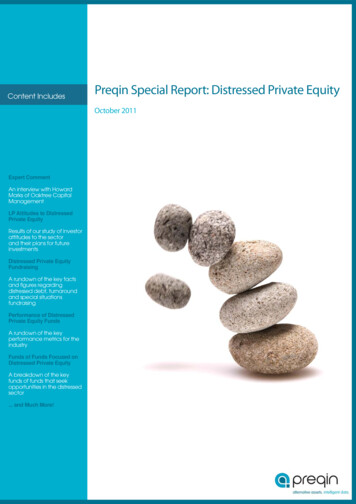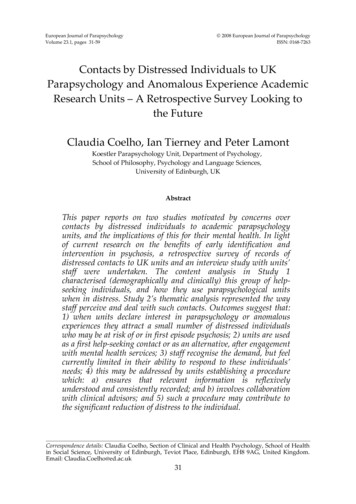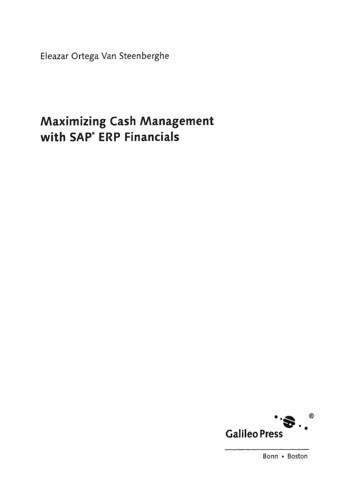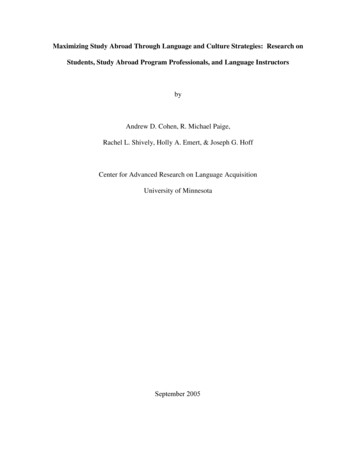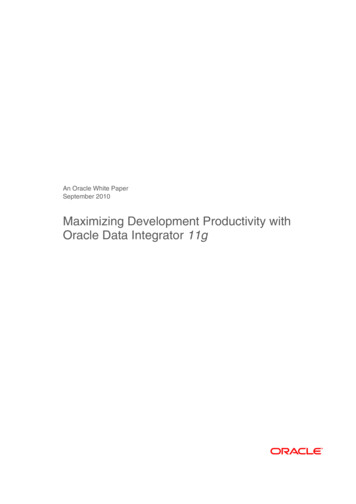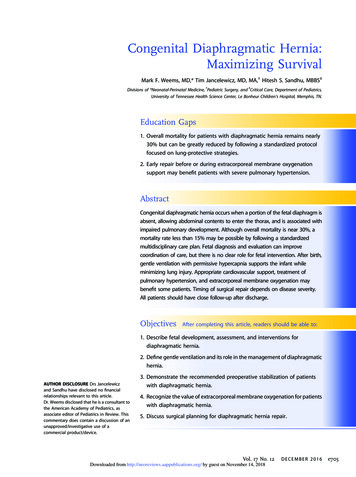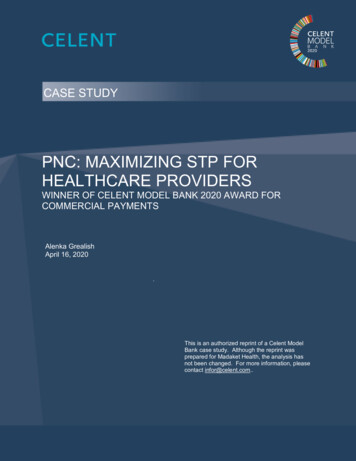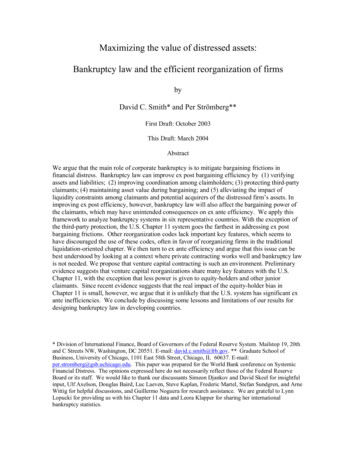
Transcription
Maximizing the value of distressed assets:Bankruptcy law and the efficient reorganization of firmsbyDavid C. Smith* and Per Strömberg**First Draft: October 2003This Draft: March 2004AbstractWe argue that the main role of corporate bankruptcy is to mitigate bargaining frictions infinancial distress. Bankruptcy law can improve ex post bargaining efficiency by (1) verifyingassets and liabilities; (2) improving coordination among claimholders; (3) protecting third-partyclaimants; (4) maintaining asset value during bargaining; and (5) alleviating the impact ofliquidity constraints among claimants and potential acquirers of the distressed firm’s assets. Inimproving ex post efficiency, however, bankruptcy law will also affect the bargaining power ofthe claimants, which may have unintended consequences on ex ante efficiency. We apply thisframework to analyze bankruptcy systems in six representative countries. With the exception ofthe third-party protection, the U.S. Chapter 11 system goes the farthest in addressing ex postbargaining frictions. Other reorganization codes lack important key features, which seems tohave discouraged the use of these codes, often in favor of reorganizing firms in the traditionalliquidation-oriented chapter. We then turn to ex ante efficiency and argue that this issue can bebest understood by looking at a context where private contracting works well and bankruptcy lawis not needed. We propose that venture capital contracting is such an environment. Preliminaryevidence suggests that venture capital reorganizations share many key features with the U.S.Chapter 11, with the exception that less power is given to equity-holders and other juniorclaimants. Since recent evidence suggests that the real impact of the equity-holder bias inChapter 11 is small, however, we argue that it is unlikely that the U.S. system has significant exante inefficiencies. We conclude by discussing some lessons and limitations of our results fordesigning bankruptcy law in developing countries.* Division of International Finance, Board of Governors of the Federal Reserve System. Mailstop 19, 20thand C Streets NW, Washington, DC 20551. E-mail: david.c.smith@frb.gov. ** Graduate School ofBusiness, University of Chicago, 1101 East 58th Street, Chicago, IL 60637. E-mail:per.stromberg@gsb.uchicago.edu. This paper was prepared for the World Bank conference on SystemicFinancial Distress. The opinions expressed here do not necessarily reflect those of the Federal ReserveBoard or its staff. We would like to thank our discussants Simeon Djankov and David Skeel for insightfulinput, Ulf Axelson, Douglas Baird, Luc Laeven, Steve Kaplan, Frederic Martel, Stefan Sundgren, and ArneWittig for helpful discussions, and Guillermo Noguera for research assistance. We are grateful to LynnLopucki for providing us with his Chapter 11 data and Leora Klapper for sharing her internationalbankruptcy statistics.
1. INTRODUCTIONMany observers have noted the historical differences between U.S. corporatebankruptcy procedures and those in other countries. The U.S. law has been described as“debtor-friendly,” oriented towards reorganizing the existing company (i.e., giving thedebtor a second chance), and accustomed to deviating from contractual payoff priorities.The traditional bankruptcy procedures in many other developed countries including theUnited Kingdom, Germany, Japan, and Sweden are described, in contrast, as “creditorfriendly,” favoring the liquidation of the debtor’s assets to pay off creditors in the orderof their priority. A relatively large literature has arisen debating the relative merits ofeach system.1Perhaps with an eye to the perceived success of the U.S. system, many countrieshave recently begun to institute more debtor-friendly, U.S.-styled reorganization codesinto their bankruptcy laws.2 Indeed, the World Bank, International Monetary Fund(IMF), and the European Union (EU) now encourage member countries to adoptbankruptcy laws that have a reorganization code as one of their cornerstones.3 Thus,from a public policy standpoint, U.S.-styled bankruptcy procedures appear to be quicklygaining the upper ground as the preferred mechanism for dealing with distressedcompanies.Yet anecdotal evidence suggests that very few of these recent reorganizationcodes adopted by countries have been successful. For example, of all firms going1Early contributions include Roe (1983), Baird (1986), Jackson (1986), Jensen (1989), and Aghion, Hart,and Moore (1992). More recently, see Strömberg (2000), Armour, Cheffins, and Skeel (2002), and Bairdand Rasmussen (2002).2In fact, each of the four European countries cited above have refurbished or added new reorganizationcodes within the last seven years (see Table 1).3For example, see World Bank Working Group on Rehabilitation (1999), and European Commission(2003).2
bankrupt in Sweden over the 2000 to 2002 period, only 0.7 percent of the firms emergedunder their new company reorganization code (Företags-rekonstruktion). Likewise, only0.4 percent of bankrupt German firms filed for protection under the reorganizationsection of the new German Insolvency Act (Insolvenzordnung).The goal of this paper is to shed some light on these issues by suggesting aconceptual framework for thinking about bankruptcy law. As a starting point, we arguethat the main role of corporate bankruptcy is to mitigate bargaining frictions in financialdistress. We identify five roles for bankruptcy law in improving ex post bargainingefficiency: (1) verify assets and liabilities, (2) improve coordination amongclaimholders, (3) protect third-party claimants, (4) maintain asset value duringbargaining, and (5) alleviate the impact of liquidity constraints among claimants andpotential acquirers. In improving ex post efficiency, however, bankruptcy law will alsoaffect the bargaining power of the claimants, which may have unintended consequenceson ex ante efficiency.We apply this framework to a comparison of the bankruptcy systems in sixdifferent countries: France, Germany, Japan, Sweden, the United Kingdom, and theUnited States. Virtually every bankruptcy system around the world can be described as avariant of one of these six systems, thus our results are likely to be applicable generally.We find that, with the exception of the protection of third-party claimants, the U.S.Chapter 11 system seems to go the farthest in addressing ex post bargaining frictions.While all the other countries have reorganization chapters of their own, which are similarto -- and often modeled after --Chapter 11, the non-U.S. chapters lack important keyfeatures.3
These weaknesses, in turn, appear to have discouraged the use of reorganizationcodes in these countries. We argue that when firms do reorganize in these countries, theydo so under traditional “liquidation” (or cash auction) chapters. At the same time, theU.S. Chapter 11 bankruptcy procedures of today are geared towards the auctioning off ofassets when it pays to do so. Hence, debtor-oriented reorganizations, sales of the assetsas a going-concern, or piecemeal liquidations can be obtained under either type of code.In fact, going-concern survival rates in countries dominated by a reorganization code canlook very similar to the survival rates in countries that mostly use a liquidation code. Thedisadvantage from reorganizing under the liquidation code, however, is that these codestypically lack provisions for maintaining asset value and alleviating liquidity constraintsduring bankruptcy, potentially leading to a forced bankruptcy resolution and inefficientallocation of assets.We then address the complicated issue of ex ante efficiency. Theoretically, an expost inefficient bankruptcy code need not necessarily be inefficient ex ante. For example,a costly bankruptcy code may provide efficient incentives for firms to avoid financialdistress in the first place. We argue that ex ante efficiency can be best understood bylooking at the resolution of financial distress in a setting where private bargaining workswell, such as venture capital (VC) financings. VC financings involve a small number ofinformed, sophisticated, and value-maximizing investors, and are therefore able to avoidmany of the bargaining frictions that bankruptcy law are aimed at mitigating. Venturecapitalist (VC) financial contracts share many of the characteristics of a typical debtcontract. Yet VC contracts typically manage to opt out of bankruptcy law, relyinginstead on provisions in the ex ante contract to resolve financial distress. Although there4
are limitations to the VC financing analogy, the VC contract provisions offer guidance onthe features that an optimal bankruptcy mechanism should incorporate.We report preliminary evidence suggesting that venture capital reorganizationsshare many key features with reorganizations in U.S. Chapter 11, such as deviations fromabsolute priority and debtor-in-possession financing. One notable difference is that lesspower is given to equity-holders and other junior claimants in VC financings. Sincerecent evidence suggests that the real impact of the equity-holder bias in Chapter 11 issmall, however, we argue that it is unlikely that the U.S. system has significant ex anteinefficiencies. Moreover, the similarities between Chapter 11 and private contractingoutcomes are hardly a coincidence, given that Chapter 11 evolved from the “equityreceiverships” that were created during the 19th century as a market response to U.S.railroad failures.The rest of the paper proceeds as follows. Section 2 discusses the role ofbankruptcy in a world of incomplete contracts. Section 3 applies this framework to aninternational comparison of bankruptcy laws. Section 4 addresses ex ante efficiency andargues that VC contracting can provide useful lessons about the construction ofbankruptcy procedures. Section 5 contains some concluding remarks.2. THE ROLE OF BANKRUPTCY IN A WORLD OF INCOMPLETECONTRACTING2.1. Financial distress and incomplete contractsFinancial distress occurs when a firm is not able to meet its debt obligations, orforesees that it will not be able to do so in the near future. If financial distress persists5
and leads to the firm defaulting on its obligations, a debt contract gives the lender certaincontrol rights, such as seizing collateral, suing for repayment, or forcing the firm intobankruptcy. These rights need not necessarily be exercised, however, but serve as astarting point for a renegotiation between creditors and the owners of the firm (andpossibly also including other stakeholders such as employees). Financial distress can beresolved outside of bankruptcy, through a private renegotiation between stakeholders.Only if one or more of the stakeholders exercise the right to put the firm in bankruptcywill distress be resolved under the rules dictated by bankruptcy law.Thanks to modern financial contracting theory, economists now have a goodunderstanding of the economic role of financial distress.4 A key to understandingfinancial distress and bankruptcy law is the insight that any financial contracts are bynature incomplete. In a world of complete, frictionless contracting, there is no need forfinancial distress and bankruptcy. Instead, when an entrepreneur or owner-managerseeks financing from investors, a complete contract will be written. This contract willspecify, for all possible future states of the world, how the cash flows of the project willbe split, in which instances the firm should be sold or liquidated, and more generally,what actions need to be taken in controlling the firm. Because the state-contingentcontract specifies when the firm should be liquidated or sold, and how much investorswill be paid back and in what order, the contract already encompasses a perfectmechanism to deal with “financial distress.” Ex ante contracting will ensure that aneconomically optimal outcome will be achieved, and the only role for the legal system isto enforce the written contracts.4See Hart (2001).6
Obviously, such complete contracts are impossible to write and enforce in reality.Many relevant states of the world are impossible to foresee in advance. The possiblestate-space is too rich to be formulated in a written contract of finite length. Over the lastfifteen years, theorists have thought extensively about what optimal financial contractsmight look like when contracts are incomplete.5A key feature of the optimal incomplete contract is to allocate control rightsbetween managers and investors in an efficient manner. Control rights are importantbecause they determine which party has the right to decide on the actions of the firm,such as whether operations should be continued or shut down, or whether managementshould be replaced. One of the robust findings from the incomplete contracting literatureis that the optimal contract often will call for control staying with the manager in thegood states of the world, while in the bad state control rights will be transferred toinvestors.6 In other words, this literature can explain why the optimal contract looks likea debt contract, where control of the firm’s assets is transferred to creditors if the firmfails to meet its contracted payments. Such control transfer mechanisms are not onlyseen in debt contracts, however, but also in the preferred equity contracts used in venturecapital financings.7A second feature of these types of models is that the outcome of financial distresscannot be specified in contracts ex ante, but will be a result of renegotiation between themanager of the firm and its claimholders. The possible outcomes that can be attained arethus limited to the ones that are consistent with renegotiation. The incompletecontracting literature thus provides a meaningful framework to think about financial5Hart (1995, 2001) provide overviews.See, for example, Aghion and Bolton (1992), Dewatripont and Tirole (1994), and Hart and Moore (1998).7See Kaplan and Strömberg (2003).
Bankruptcy law and the efficient reorganization of firms by David C. Smith* and Per Strömberg** First Draft: October 2003 This Draft: March 2004 Abstract We argue that the main role of corporate bankruptcy is to mitigate bargaining frictions in financial distress. Bankruptcy law can improve ex post bargaining efficiency by (1) verifying
